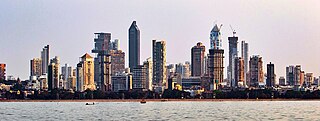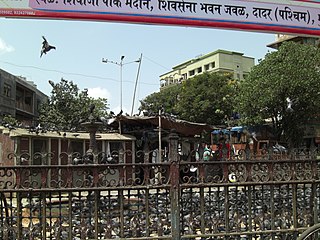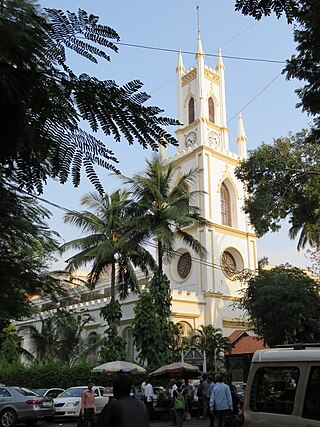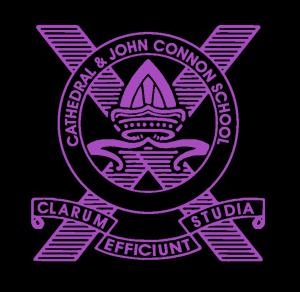
Mumbai is the capital city of the Indian state of Maharashtra. Mumbai is the financial capital and the most populous city of India with an estimated population of 12.5 million (1.25 crore). Mumbai is the centre of the Mumbai Metropolitan Region, the sixth-most populous metropolitan area in the world with a population of over 23 million. Mumbai lies on the Konkan coast on the west coast of India and has a deep natural harbour. In 2008, Mumbai was named an alpha world city. Mumbai has the highest number of billionaires out of any city in Asia.
Old Goa is a historical site and city situated on the southern banks of the River Mandovi, within the Tiswadi taluka (Ilhas) of North Goa district, in the Indian state of Goa.

Bandra ([bæːɳɖɾa]) is a coastal suburb located in Mumbai, the largest city of the Konkan division in Maharashtra, India. The area is located to the immediate north of the River Mithi, which separates Bandra from the Mumbai City district. It is the third-largest commercial hub in Maharashtra, after the Mumbai City and Pune, primarily aided by the Bandra Kurla Complex.

Dadar ([d̪aːd̪əɾ]) is a densely populated residential and shopping neighbourhood in Mumbai. It is also a prominent railway and bus service hub with local and national connectivity. It is Mumbai’s first planned area and it's a hub for the city's Marathi culture.
Matunga is a Suburb in Mumbai, India. It is accessible from the Matunga Road station on the Western line, Matunga station on the Central Line and King's Circle station on the Harbour Line.

Kurla is a suburb of East Mumbai, India. It is the headquarters of the Kurla taluka of Mumbai Suburban district. The neighbourhood is named after the eponymous East Indian village that it grew out of. It falls under Zone 5, Ward 'L' of the Bombay Municipal Corporation. Its railway station, spelt as Coorla until 1890, is one of the busiest on the Mumbai suburban railway on the central and harbour railway lines of Mumbai as is the Lokmanya Tilak Terminus (LTT) for out-station passenger/express trains.

South Mumbai, colloquially SoBo from South Bombay in Indian English, administratively the Mumbai City District, is the city centre and the southernmost precinct of Greater Bombay. It extends from Colaba to Mahalaxmi, Byculla and Mazgaon neighbourhoods, and comprises the city's old and formerly main business localities, making it the wealthiest urban precinct in India. Property prices in South Mumbai are by far the highest in India and among the highest in the world. In terms of Maharashtra Legislative Assembly, the precinct consists of the constituencies of Colaba, Mumbadevi, Malabar Hill and Byculla.

Dharavi is a residential area in Mumbai, Maharashtra, India. It has often been considered to be one of the world's largest slums. Dharavi has an area of just over 2.39 square kilometres and a population of about 1,000,000. With a population density of over 277,136/km2 (717,780/sq mi), Dharavi is one of the most densely populated areas in the world.

Wadala is a neighborhood in Mumbai. Wadala Road is a station on the Harbour Line of Mumbai's railway network.

Thane Creek, previously Thana Creek, is an estuary of Arabian Sea and one of the two main distributaries of the Ulhas River, in Konkan division of Maharashtra, India. The Ulhas splits at the northeast corner of Salsette island into its two main distributaries, the other one being the Vasai Creek, both of which empty into the Arabian Sea. The creek forms the eastern boundary of Salsette island and separates the island from mainland of Konkan. It gets its name from the city of Thane, reviously Thana, located on eastern banks of the creek.

The history of Mumbai can be traced back to 600 BC, with evidence of the first known settlement of the Harrappan civilization discovered in the region.

The Bombay East Indians, also called East Indian Catholics or simply East Indians, are an ethno-religious Indian Christian community native to the Seven Islands of Bombay and the neighbouring Mumbai Metropolitan Area of the Konkan division, along the western coast of India.

St. Thomas Cathedral, Mumbai, is the 300-year old cathedral church of the Anglican Diocese of Mumbai of the Church of North India. It is named in honour of Saint Thomas the Apostle, who is believed to have first brought Christianity to India. The cathedral is located in Horniman Circle, the historic centre of Mumbai. It is in close proximity to famous Mumbai landmarks such as Flora Fountain and Bombay House. It is the oldest church in Mumbai The Cathedral and John Connon School is run by the cathedral.

The Cathedral and John Connon School is a co-educational private school founded in 1860 and located in Fort, Mumbai, Maharashtra. The school is widely considered to be amongst the best and most prestigious schools in India, housing five sections: Pre-Primary, Infant, Junior, Middle and Senior Schools.

Chinchpokli is a neighbourhood in South Mumbai. It is also the name of a railway station on the Central line of the Mumbai suburban railway. Historical British era spellings include Chinchpugli and Chinchpooghly. The neighbourhood is named after the Marathi words for tamarind (chinch) and betel nut (pofali).
Indigenous tribals have inhabited Mumbai (Bombay) since the Stone Age. The Kolis and Aagri were the earliest known settlers of the islands. Between the 2nd century BCE and 10th century CE, the islands came under the control of successive indigenous dynasties: the Satavahanas, Abhiras, Vakatakas, Kalachuris, Konkan Mauryas, Chalukyas, Rashtrakutas, Silharas & Cholas.
The architecture of Mumbai blends Gothic, Victorian, Art Deco, Indo-Saracenic & Contemporary architectural styles. Many buildings, structures and historical monuments remain from the colonial era. Mumbai, after Miami, has the second largest number of Art Deco buildings in the world.

Holy Cross Church, Kurla is a Roman Catholic Church in Kurla, a suburb of Mumbai, India. It was built during the Portuguese era by the Jesuits in 1588 and rebuilt in 1848. It is one of the oldest churches in Mumbai. The church belongs to the Archdiocese of Bombay.

Tourism in Mumbai (Bombay) is an industry that attracts almost 6 million tourists per year, making it the 30th-most visited location worldwide. According to United Nations, as of 2018, Mumbai was the second most populous city in India after Delhi and the seventh most populous city in the world with a population of 19.98 million.

Christ Church in Byculla, Mumbai, is affiliated to the Church of North India and was built in 1833 as an Anglican church. The church's establishment has been the subject of a myth that it was built to suit the convenience of the Governor of Bombay, Mountstuart Elphinstone, who reportedly had to earlier travel from his central Bombay residence in Parel to St Thomas Cathedral in South Bombay. Elphinstone had already left India in 1829. The church was, in fact, built during the governorship of John FitzGibbon, 2nd Earl of Clare, who laid the foundation stone in July, 1832.



















